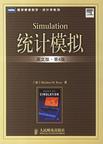统计模拟
出版时间:2007-2 出版社:人民邮电 作者:罗斯 页数:298
Tag标签:无
内容概要
“……本书内容丰富,不论作为教材还是参考书都非常值得推荐。”——美国统计学报 “本书是一本非常优秀的教材,强调了计算机在模拟技术上的应用。一定的概率和统计知识将有助于理解本书的精髓。”——亚马逊网上书店评论 统计模拟是一门新兴的统计学和计算机结合的学科,因其便利性和经济性而广泛应用于统计学、数学、精算科学、工程学、物理学等众多领域,用以获得精确而有效的解决方案。 本书是国际知名统计学家Sheldon M. Ross所著的经典教材,已被加州大学伯克利分校、哥伦比亚大学等多所名校采用。书中涵盖了统计模拟最新方法和技术,提供了丰富的实例,备受业界推崇。 本书特色: 提供了分析模拟数据以及模拟模型的拟合检验所需的统计方法。 通过许多实用的例子(如多服务器排队法、存货控制及行使股票期权等)来阐明和提出理论。 强调方差缩减技术,包括控制变量及它们在因归分析中的应用等。 提供了有关保险风险模型、生成随机向量、奇异期权的材料和关于产生离散随机变量混淆方法的独特材料。 第4版特别增加了随机序列函数和随机子集函数的评估、分层抽样法的应用。 本书介绍了统计模拟的一些实用方法和技术。在对概率的基本知识进行了简单的回顾这后,介绍了如何利用计算机产生随机数以及如何利用这些随机数产生任意分布的随机变量、随机过程等。然后介绍一些分析编译数据的方法和技术,如Bootstrap、方差缩减技术等。接着介绍了如何利用统计模拟来判断所选的随机模型是否拟合实际的数据。最后介绍了MCMC及一些最新发展的统计模拟技术和论题。本书可作为统计学、计算数学、保险学、精算学等专业本科生教材,也可供相关专业人士参考。本书为英文第4版。
作者简介
Sheldon,M.Ross,国际知名概率与统计学家,南加州大学工业工程民运筹系系主任。毕业于斯坦福大学统计学,曾在加州大学伯克利分校任教多年。研究领域包括:随机模型、仿真模拟、统计分析、金融数等。Ross教授著述颇丰,他的多种畅销数学和统计教材均产生了世界性的影响,如Introduction to Probability Models(《应用随机过程:概率模型导论》),A Fisrt Course in Probability(《概率论基础教程》)等(均由人民邮电出版社出版)。
书籍目录
1 IntroductionExercises2 Elements of Probability2.1 Sample Space and Events2.2 Axioms of Probability2.3 Conditional Probability and Independence2.4 Random Variables2.5 Expectation2.6 Variance2.7 Chebyshevs Inequality and the Laws of Large Numbers2.8 Some Discrete Random VariablesBinomial Random VariablesPoisson Random VariablesGeometric Random VariablesThe Negative Binomial Random VariableHypergeometric Random Variables2.9 Continuous Random VariablesUniformly Distributed Random VariablesNormal Random VariablesExponential Random VariablesThe Poisson Process and Gamma Random VariablesThe Nonhomogeneous Poisson Process2.10 Conditional Expectation and Conditional VarianceExercisesReferences3 Random NumbersIntroduction3.1 Pseudorandom Number Generation3.2 Using Random Numbers to Evaluate IntegralsExercisesReferences4 Generating Discrete Random Variables4.1 The Inverse Transform Method4.2 Generating a Poisson Random Variable4.3 Generating Binomial Random Variables4.4 The Acceptance-Rejection Technique4.5 The Composition Approach4.6 Generating Random VectorsExercises5 Generating Continuous Random VariablesIntroduction5.1 The Inverse Transform Algorithm5.2 The Rejection Method5.3 The Polar Method for Generating Normal Random Variables5.4 Generating a Poisson Process5.5 Generating a Nonhomogeneous Poisson ProcessExercisesReferences6 The Discrete Event Simulation ApproachIntroduction6.1 Simulation via Discrete Events6.2 A Single-Server Queueing System6.3 A Queueing System with Two Servers in Series6.4 A Queueing System with Two Parallel Servers6.5 An Inventory Model6.6 An Insurance Risk Model6.7 A Repair Problem6.8 Exercising a Stock Option6.9 Verification of the Simulation ModelExercisesReferences7 Statistical Analysis of Simulated DataIntroduction7.1 The Sample Mean and Sample Variance7.2 Interval Estimates of a Population Mean7.3 The Bootstrapping Technique for Estimating Mean Square ErrorsExercisesReferences8 Variance Reduction TechniquesIntroduction8.1 The Use of Antithetic Variables8.2 The Use of Control Variates8.3 Variance Reduction by ConditioningEstimating the Expected Number of Renewals by Time t8.4 Stratified Sampling8.5 Importance Sampling8.6 Using Common Random Numbers8.7 Evaluating an Exotic OptionAppendix: Verification of Antithetic Variable ApproachWhen Estimating the Expected Value of Monotone FunctionsExercisesReferences9 Statistical Validation TechniquesIntroduction9.1 Goodness of Fit TestsThe Chi-Square Goodness of Fit Test for Discrete DataThe Kolmogorov-Smirnov Test for Continuous Data9.2 Goodness of Fit Tests When Some Parameters Are UnspecifiedThe Discrete Data CaseThe Continuous Data Case9.3 The Two-Sample Problem9.4 Validating the Assumption of a NonhomogeneousPoisson ProcessExercisesReferences10 Markov Chain Monte Carlo MethodsIntroduction10.1 Markov Chains10.2 The Hastings-Metropolis Algorithm10.3 The Gibbs Sampler10.4 Simulated Annealing10.5 The Sampling Importance Resampling AlgorithmExercisesReferences11 Some Additional TopicsIntroduction11.1 The Alias Method for Generating Discrete Random Variables11.2 Simulating a Two-Dimensional Poisson Process11.3 Simulation Applications of an Identity for Sums of Bernoulli Random Variables11.4 Estimating the Distribution and the Mean of the First Passage Time of a Markov Chain11.5 Coupling from the PastExercisesReferencesIndex
图书封面
图书标签Tags
无
评论、评分、阅读与下载
用户评论 (总计0条)
相关图书
- Excel2003财务应用快易通
- PowerPoint2003办公范例快易通
- PowerPoint2003多媒体演示快易通
- Word/Excel/PowerPoint高效办公
- SolidWorks 2006基础教程
- Visual Basic NET程序设计
- C++程序设计
- JAVA程序设计
- 从零开始:SQL Server 2005中文版基础培训教程
- 16位语音型单片机SPCE061A实用教程
- 计算机网络技术基础
- 中国最新公路交通地图集
- 形象美化漂亮女人
- 中国美术全集(全套60册)
- 汉藏佛教艺术研究
- 八年级语文 语文版下
- 数学四年级(下)(配北京师范大学出版社实验教科书)-一课3练-(双色)(改进版)
- 七年级思想品德下
- 八年级英语下
- 七年级语文下
- 七年级数学下
- 历史
- 八年级语文下
- 八年级英语(上)
- 母亲 我的大学 (平装)
